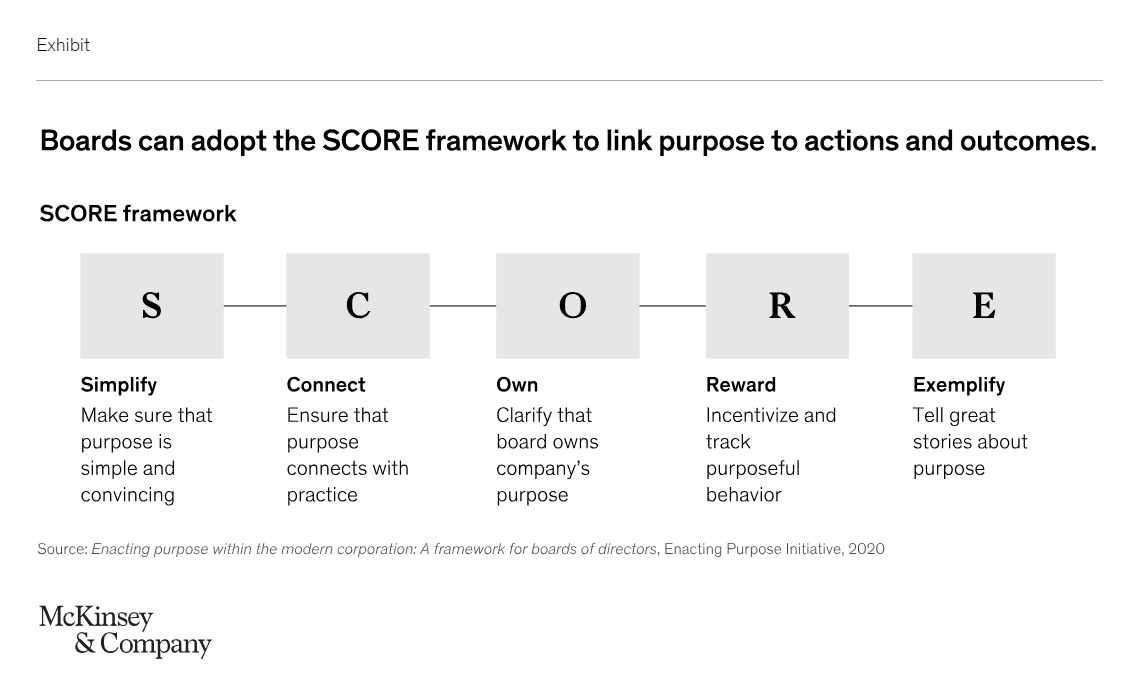Answering three questions about purpose and environmental, social, and governance issues can help business leaders zero in on what matters most for their organizations.
Purpose and environmental, social, and governance (ESG) issues represent critical challenges for both boards and executive teams. They have become particularly salient since the COVID-19 pandemic, which has forced corporations to scrutinize their responsibilities and role in society. In this episode of the Inside the Strategy Room podcast—one of three exploring the various challenges around ESG—two experts who have long studied the connection between purpose and ESG explain how to align these commitments and embed them in organizations’ lived experiences. Rupert Younger is the founder of the Centre for Corporate Reputation at Oxford University and chairs the Enacting Purpose Initiative, a multi-institution partnership that works to establish best practices around purpose governance. Robin Nuttall is a leader in McKinsey’s ESG and regulatory strategy work. This is an edited transcript of the discussion. For more conversations on the strategy issues that matter, follow the series on your preferred podcast app.
Sean Brown: Robin, can you start by describing the difference between ESG and purpose?
Robin Nuttall: Three things matter when it comes to purpose and ESG. The first is why. Purpose answers the question of why your company exists. What is its positive impact on the world? Why do employees get out of bed in the morning and come to work? That is underpinned by purposeful activity, which often takes the form of environment, social, and governance factors.
The why needs to link to the what, which is your fundamental business strategy. Which markets and product categories do you participate in and which ones do you stay out of? What is your bold commitment to the people and the planet? Finally, the how is the operating model. It is relatively easy to get to a purpose statement that would appear at the top of your website. What is more challenging is making it live in the organization.
Sean Brown: Where is the pressure to focus on ESG and purpose primarily coming from—investors, customers, employees?
Robin Nuttall: There has been a shift in stakeholder attitudes across the board. Start with employees: 70 percent now demand purposeful work. They want the company they work for to take a strong position on social issues. Customers are also making choices in the marketplace based on purpose and sustainability. Millennials and Gen Z have very different attitudes to purpose than baby boomers do and are much more favorable toward sustainable businesses. Regulators are also getting very interested in ESG and purpose. The European Union has already implemented the Non-Financial Reporting Directive [requiring companies to report how they manage social and environmental challenges], and the Securities and Exchange Commission [SEC] has started to evaluate ESG measures in the United States. Then there is the critical investor space.
Sean Brown: Rupert, you have done a lot of research on corporate purpose. Why is it such a focus for stakeholders now?
Rupert Younger: We have observed, particularly in the research over the past two years with the Enacting Purpose Initiative, a return to more balanced capitalism. This ties into the debate about whether Milton Friedman’s ideals about what capitalism should look like need to be revised. This idea that one stakeholder, the shareholder, is all you need to focus on as a manager and board director is being overturned by a global movement challenging that assumption. Capitalism as a concept came into existence in the mid-1800s, but the idea of how business should balance its different stakeholder interests is a tale going back millennia. We are now seeing a return to the idea that business needs to serve the interests of multiple stakeholder groups to achieve the outcomes that it seeks.
Sean Brown: What role are investors playing in this push for more balanced capitalism and what do they want to see?
Rupert Younger: The interesting development is that shareholders are in the vanguard of the movement for purpose, and certainly for ESG adoption. Last year, we convened 31 asset owners and managers, some of the biggest names in the world, to help us think through these issues. Five big themes emerged. The first is having clarity on what matters. Investors are not interested in frothy statements but in understanding how purpose is material to the performance of the business. The second is evidence of metrics. Investors want businesses to be much clearer on why purposeful activity produces business outcomes. They also want to see how senior-executive teams are aligned through their incentive systems to deliver purposeful activity. The fourth area is how purpose informs capital allocation decisions, both financial and human capital. The final concern is standardization of reporting. There has been an explosion of different reporting mechanisms, which is not necessarily helpful, but as in any new frontier, you will start to see coalescing around the most powerful and easy-to-adopt standards.
Sean Brown: How exactly do purpose and ESG interrelate?
Robin Nuttall: We think about it as a grid with two axes. On one axis is whether you have strong or poor ESG performance and on the other is your purpose that sets your “North Star.” You need to make sure that your ESG commitments deliver on the goals your purpose sets. The pitfall is that you may state a purpose but have no plan to deliver on it, or you may have a plethora of ESG programs, but nothing ties them together in terms of that North Star.
Sean Brown: How does that alignment influence financial performance? Rupert, you and your Oxford University colleagues have looked at the links between ESG and value creation.
Rupert Younger: We looked at companies on the NYSE and Nasdaq that had strong ESG records at the start of the pandemic, both when markets started to collapse and from March 23rd onward, when the markets began to recover. In both of those periods, companies with better ESG records outperformed those with low records. We did the usual regressions, even accounting for changes in ownership and optimality levels, and saw the same outperformance, both in falling and rising markets. The work done by George Serafeim at Harvard and by others also strongly links purposeful activity with productivity and performance improvements driven by employee engagement. The point is that purpose does not come at the expense of profitability but, in many cases, drives outperformance.
Sean Brown: What is behind this higher capital-markets performance by ESG-focused companies?
Purpose does not come at the expense of profitability but, in many cases, drives outperformance.
Robin Nuttall: We talked about topline growth and customer preferences, whether that is consumers or businesses or governments—you increasingly need sustainable business models to win government contracts. There is also an advantage of having better relationships with regulators if you articulate your societal impact clearly. You can also gain higher resource efficiency. A green supply chain is often a lean supply chain as you remove redundancy and waste. Finally, as Rupert mentioned, you attract better talent and raise productivity. All this can translate into an advantage in the capital markets.
Sean Brown: Companies have to make trade-offs to create more sustainable practices, whether that is making investments or forgoing business opportunities. How do you find them approaching those?
Robin Nuttall: In the near term, there are very real trade-offs. We have developed a model that can help executives and boards with these decisions. It revolves around what we call the 5Ps. First, do your portfolio and products reflect your purpose? CVS Pharmacy famously stopped selling tobacco as it adopted a health-oriented purpose. Number two, people and culture: are you aligning your recruiting and promotion decisions? Thirdly, processes and systems: are you embedding purpose into your supply chain and capital allocation?
Then you have performance metrics and, lastly, positions and engagement. What is your external position? Some oil and gas companies recently withdrew from trade associations whose positions did not reconcile with the companies’ new purpose statements.
We are starting to see industries take an end-to-end view through these lenses. Some energy companies have fully adopted the 5P model. It starts with the portfolio strategy where they divest high-carbon assets and shift toward renewables. They have started embedding purpose in their people and culture, in how they attract and retain talent. They are driving out methane emissions from their operational processes and applying metrics that fit with their purpose, such as greenhouse-gas targets wired into manager incentives. And, as I mentioned, their purpose affects their external affiliations.
Sean Brown: What role are boards playing in fostering this focus on purpose in the organizations?
Rupert Younger: Purposeful activity needs to be well governed. The Enacting Purpose Initiative has put forward a framework called the SCORE model to help boards oversee purpose, and it comprises five simple questions [exhibit]. First, is your purpose simple enough to be understood by everyone? Organizations often overcomplicate. If purpose is to be meaningful, it needs to connect to every level and function in the organization. The second is how does it connect to your strategy? If boards think of purpose as a marketing or cultural driver, that will not deliver its full value. Purpose has to drive strategy and connect why you exist as a company to the choices you make. The third question is about ownership. How is purpose lived, owned, and brought to life within the organization, and who owns it?

The fourth area covers the reward system, and not just in terms of financial rewards but also promotion and opportunities to work on teams and projects. The final area, which emerged out of our meetings with senior board directors and investors, is the power of storytelling. The human race has long built connections through stories. When people talk about purposeful activity around the watercooler and share examples throughout the organization, that can be a powerful way of turning purpose intent into purpose action.
Sean Brown: How are companies aligning executive rewards and incentives with the corporate purpose?
Robin Nuttall: A recent study found that 29 percent of companies now include various ESG metrics in their incentive plans, up from 22 percent a year ago. So just as COVID-19 has accelerated sustainable investing, it has accelerated action on this topic. The areas with the strongest focus are social metrics, such as diversity and inclusion, with more than 88 percent of companies linking compensation to social and people metrics.
Sean Brown: Rupert, you mentioned earlier the proliferation of different models for measuring ESG. Are you seeing points of consensus emerging on metrics?
Rupert Younger: In January, we published a working paper that put forward an approach to measuring purpose. Historically, people talked about motives—the mission, the strategy, why the company exists—and then moved straight to how they affect the balance sheet or profit and loss statement. We argue that this is not enough. There needs to be a middle step, which is metrics, for two reasons. Number one, businesses use metrics when they think about what assets they deploy and what outputs they produce. In the case of purpose, will it increase employee engagement or diversity? Will it improve community engagement? Is it about improving supply chains? There will be various outputs you can focus on that are business imperatives. You also need to look at what changes as a result of those metrics, or the outcomes, and the impacts—the effects on well-being. Looking at metrics helps businesses and investors put a monetary value on the inputs and the outputs, the outcomes and the impact.
Sean Brown: Business leaders often struggle to communicate their companies’ purpose and ESG in a way that investors recognize and reward. How can they get that message out effectively?
Rupert Younger: Investors want to understand why your purpose matters. You need to articulate how you can help to profitably solve a set of problems relating to people or the planet. Your ESG commitments then flow from that articulation. Companies find it difficult to connect with investors if they start with ESG without those initiatives being anchored in your reason to exist. Investors need to understand why you are pursuing ESG commitments. You often find organizations chasing the latest big ESG issues. The smart companies anchor themselves in a purpose, and their ESG commitments follow.
Robin Nuttall: We hear that from quite a few clients: “We are communicating a lot on this, but we don’t feel we are getting credit.” In addition to Rupert’s point, make sure you are talking about something material that has value to your business. The notion of a road map is also powerful. Investors don’t expect you to change your business overnight, especially if you have a strong legacy in fossil fuels or food products now perceived as less healthy. They want to see a bold road map and a trajectory to improvement. We saw situations last year where oil and gas companies came out with ten-year road maps for decarbonization, and the industry and capital markets’ response was extremely positive.
The notion of a road map is powerful. Investors don’t expect you to change your business overnight, especially if you have a strong legacy in fossil fuels or food products now perceived as less healthy. They want to see a trajectory to improvement.
Rupert Younger: I would particularly stress the value of having milestones. There has been a lot of talk around ESG and purposeful activity, and investors now want to see progress. You cannot pivot an organization overnight, but you can show intent. That could mean immediate allocations of capital or investments you have chosen not to pursue.
Sean Brown: Where should responsibility reside for guiding this purpose journey? Should companies appoint chief ESG officers who report to the CEO?
Robin Nuttall: This is very much a CEO-level topic. The CEO is the only person who can integrate purpose across the organization and take the leadership of projecting the purpose in ESG. Of course, you need to develop the ESG strategy and communications, and some companies are appointing chief ESG officers or chief sustainability officers who often connect with government and public affairs. That is an increasingly common portfolio at the top-management table. But it is critical for business unit leaders to be involved and champion this. What we find to be most effective at the operational level is for chief sustainability officers to act as pivot points but develop the purpose and the ESG jointly with the business unit leaders.
Sean Brown: Do you believe that every company, regardless of industry, can become purpose-driven?
Rupert Younger: Absolutely the answer is yes. Purpose does not have to be something flowery and beautifully constructed. It is a simple articulation of what issues that affect people or the planet you are trying to solve. This can be remarkably powerful whether you are making nuts and bolts or you are an energy company or an investment firm. You can articulate why you deserve the license to exist. This comes back to the idea of the corporation—the corporation is a legal fiction. It is given its license to operate by society.
Sean Brown: What are the key early decisions that business leaders who want to embed a purpose in their organizations need to make?
Robin Nuttall: I would call out two things. Number one is to pose the question about materiality and value at stake. What factors matter to my business and my stakeholders above all else? The second question is about focus. Some of the most successful ESG leaders have a focus, whether on sustainable living or reimagining food, and that drives two or three clear ESG commitments. Ask yourself what one or two topics you want to lead in your sector versus those topics where you are content to share the lead with others or follow. That focus will give you more impact, both with your colleagues and with the markets.
Robin Nuttall is a partner in McKinsey’s London office. Rupert Younger is the founder of the Centre for Corporate Reputation at Oxford University and chair of the Enacting Purpose Initiative. Sean Brown is global director of communications for McKinsey’s Strategy & Corporate Finance Practice and is based in the Boston office.
The article was first published here.
Photo by Jamie Street on Unsplash.

 5.0
5.0 




















